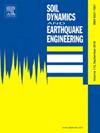2023年12月18日鸡石山6.2级地震序列的强地面运动特征
IF 4.2
2区 工程技术
Q1 ENGINEERING, GEOLOGICAL
引用次数: 0
摘要
2023年12月18日,中国西部甘肃省积石山县发生6.2级地震。中国地震预警网络(CEEWN)利用高密度微机电系统(MEMS)传感器和力平衡加速度计(FBAs)捕获了大量近场地面运动数据。通过对MEMS/FBA记录的噪声水平和可用频率范围进行评估,我们编制了一个强震数据集,其中包括Ms6.2主震和13次余震(Ms≥3.0)。对该数据集的分析揭示了不同时期峰值地面加速度(PGA,在N002B站高达1.1 g)、峰值地面速度(PGV)和频谱加速度(SAs)的空间分布和衰减模式,揭示了不同的震源特征和场址效应。主震近断层运动表现出明显的短周期能量,由于上盘效应、土壤放大和地形影响,在强度带VII-VIII, 0.2 s SAs超过1.0 g。SSR分析表明,位点非线性在1hz以上,扩增在1 ~ 10hz之间。观测到的PGAs和短周期sa以更快的衰减速率超过了地面运动模型(GMM)的预测,而长周期sa (>1.0 s)仍低于预测。强度测量(IMs)和水平-垂直频谱比(hvrs)的残差分析显示了渐进的站点非线性,显示PGAs >;500 cm/s2时HVSR频率降低和幅度下降。该数据集推动了区域地面运动模型(GMM)的发展,而我们关于强地面运动特征的发现为地震损害评估和灾后重建提供了重要见解。本文章由计算机程序翻译,如有差异,请以英文原文为准。
Strong ground motion characteristics of December 18, 2023, Jishishan Ms6.2 earthquake sequence observed from a dense network of intensity meters and accelerographs
On December 18, 2023, an Ms6.2 earthquake struck Jishishan County, Gansu Province, in western China. The China Earthquake Early Warning Network (CEEWN) captured extensive near-field ground motion data using high-density microelectromechanical system (MEMS) sensors and force-balanced accelerographs (FBAs). Through noise level and usable frequency range assessments of MEMS/FBA recordings, we compiled a strong-motion dataset encompassing the Ms6.2 mainshock and 13 aftershocks (Ms ≥ 3.0). Analysis of this dataset revealed distinct source characteristics and site effects through spatial distributions and attenuation patterns of peak ground acceleration (PGA, up to 1.1 g at station N002B), peak ground velocity (PGV), and spectral accelerations (SAs) across various periods. The mainshock's near-fault motions exhibited pronounced short-period energy, with 0.2 s SAs exceeding 1.0 g in intensity zones VII-VIII due to hanging wall effects, soil amplification, and topographic influences. Site-to-reference ratio (SSR) analysis identified site nonlinearity above 1 Hz and amplification between 1 and 10 Hz. Observed PGAs and short-period SAs surpassed ground motion model (GMM) predictions with faster attenuation rates, while long-period SAs (>1.0 s) remained below predictions. Residual analysis of intensity measures (IMs) and horizontal-to-vertical spectral ratios (HVSRs) demonstrated progressive site nonlinearity, showing HVSR frequency reductions and amplitude declines at PGAs >500 cm/s2. This dataset advances regional ground motion model (GMM) development, while our findings on strong ground motion characteristics offer critical insights for earthquake damage assessment and post-disaster reconstruction.
求助全文
通过发布文献求助,成功后即可免费获取论文全文。
去求助
来源期刊

Soil Dynamics and Earthquake Engineering
工程技术-地球科学综合
CiteScore
7.50
自引率
15.00%
发文量
446
审稿时长
8 months
期刊介绍:
The journal aims to encourage and enhance the role of mechanics and other disciplines as they relate to earthquake engineering by providing opportunities for the publication of the work of applied mathematicians, engineers and other applied scientists involved in solving problems closely related to the field of earthquake engineering and geotechnical earthquake engineering.
Emphasis is placed on new concepts and techniques, but case histories will also be published if they enhance the presentation and understanding of new technical concepts.
 求助内容:
求助内容: 应助结果提醒方式:
应助结果提醒方式:


